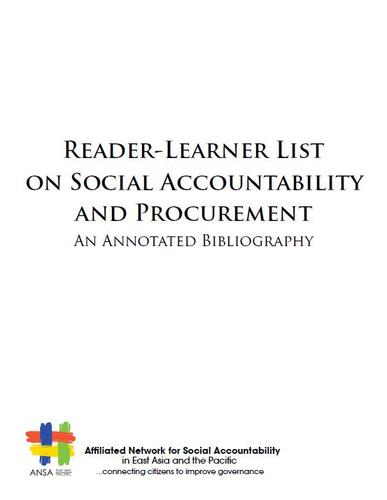On Social Accountability
Framed within the emerging era of citizen participation, this Reader’s Reference cites John Ackerman’s “Social accountability in the public sector: a conceptual discussion” (2005), where he considers social accountability as the new response to development challenges following the failures of state- and market-led mechanisms. It marks the citizen sector as the new central force that will determine the course of development, particularly in governance.
From this background, the Reader’s Reference proceeds in consulting various authors in identifying the important connecting threads, namely:
- Government’s openness and support;
- Organized citizenry;
- Access to information; and
- Shared culture.
In the paper, “Gaining support for social accountability mechanisms,” Harry Blair (2007) raises the crucial role of the government in social accountability. He illustrates the entire spectrum of state response to and posturing on citizens’ participation in governance. Knowing how to utilize and optimize the affirmative side of this spectrum provides an effective jumping board for any social accountability effort.
One, however, should still be careful in entering the door of participation that the government opens to citizens. Sherry Arnstein’s “A ladder of citizen participation” (originally published in 1969) provides a critical guide to advance from superficial to a more empowering and genuine type of engagement with government.
But to realize more fully the virtue of participation, Khalid Malik and Swarnim Wagle (2002) argues in “Civic engagement and development” for the importance of its collective embodiment. This presents the second connecting thread of social accountability as a relational value, which requires the formation and consolidation of social capital. It must foster organization and solidarity, which will allow the citizen sector to pose both micro- and macro-level counterbalance to the institutionalized machinery of the government.
Now, what should be the citizens’ instrument to hold the government accountable? The answer to this constitutes the third connecting thread of social accountability, which is information. In the paper, “Access to information: whose right and whose information,” Jeremy Pope (2003) problematizes the prevalent tendencies of government and many other social institutions to be secretive, which encourages abuses and corruption. He contends that access to information is a right and a source of empowerment. It has to be guaranteed and, moreover, translated into an ethic and culture of governance.
The principle of access to information, of course, has its limitations, as discussed by David Arellano-Gault (2008) in “An organizational analysis of transparency: ‘transparency failures’ as an instrument for incorporating effective transparency policies into public organizations.” As a social accountability thread, it connects more firmly when used in a proper and reasonable way, balancing control, on the one hand, and trust, on the other.
For the fourth connecting thread, this Reader’s List presents social accountability as a situated practice of a particular society and culture. Andrea Cornwall’s (2002) “Making spaces, changing places: situating participation in development,” provides an enlightening discussion on such approach. By implication, it invites us to view social accountability as a product of the people’s shared understanding, which results in the exploration and framing of a democratic space that defines and redefines as well as builds and rebuilds the fundamental role of citizens in the sphere of governance.
In the final analysis, social accountability is all about citizens engaging the government to improve the way government accounts for and ultimately delivers services to the citizens. As circuitous as it may sound, the threads of social accountability naturally weaves into an image of citizens partaking of governance. It reclaims the real meaning of a dynamic governance from one that sets government and citizens apart to one that champions their critical integration. It provides a venue where both government and citizens can converge to restore the essence and integrity of true democracy. Click here to get PDF
 On Procurement
On Procurement
This Reader-Learner Reference provides a menu of reading materials on social accountability with focus on the public procurement process. It is intended for public procurement practitioners who want to make the public procurement process transparent and accountable with the end of meeting its development objective.
The list provides reading materials that help one to understand the underlying concepts of procurement monitoring. There are reading materials that look into value for money, cost management, design quality and supply chain management. The list also gives leads to questions like “When do you disclose the budget in the course of the procurement?”, “How do you pre-qualify bidders (candidate contractors)?”, and “How do you debrief losing bidders?”
The list also provides a model “Code of Good Practice” for customers (government) and suppliers (bidders or contractors). This code is further iterated by Transparency International (TI) in its Integrity Pact.
On the part of civil society organizations (CSOs) and other citizen groups involved in procurement monitoring, the list gives specific reading materials on procurement monitoring and whether public procurement has delivered on its promise. One can get a glimpse of procurement monitoring practices as experienced by Textbook Count, Government Watch, Bantay Eskwela, PDAF (Priority Development Assistance Fund) Watch, Road Watch, and many others.
The list is not meant to be prescriptive nor does it claim to be comprehensive. But it is hoped that the materials listed here will lead one to search for other, more relevant procurement monitoring materials.
To help the readers browse through the list, the materials are framed under three categories. These are organizing, engaging, and ensuring. Click here to get PDF
